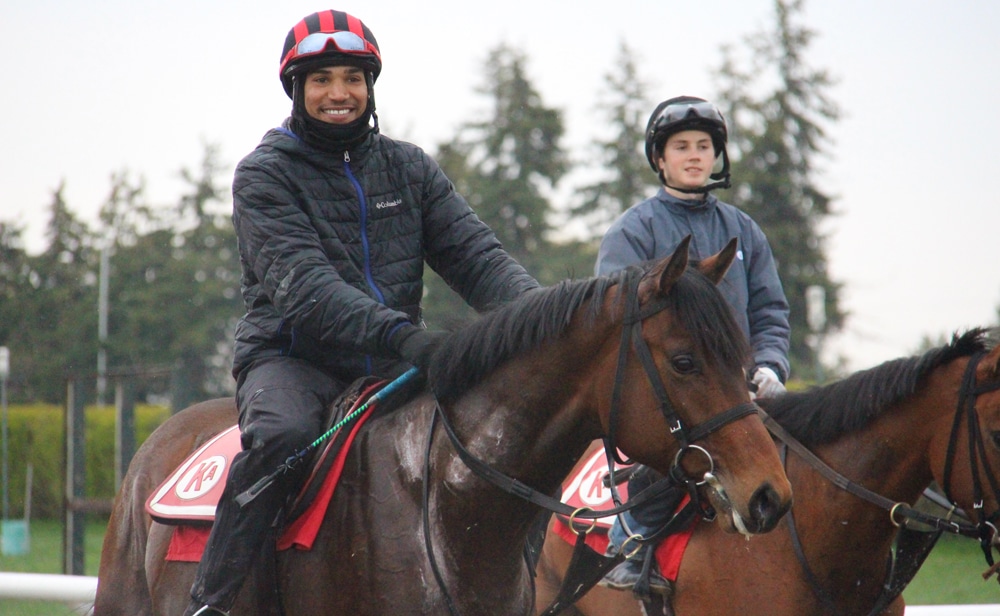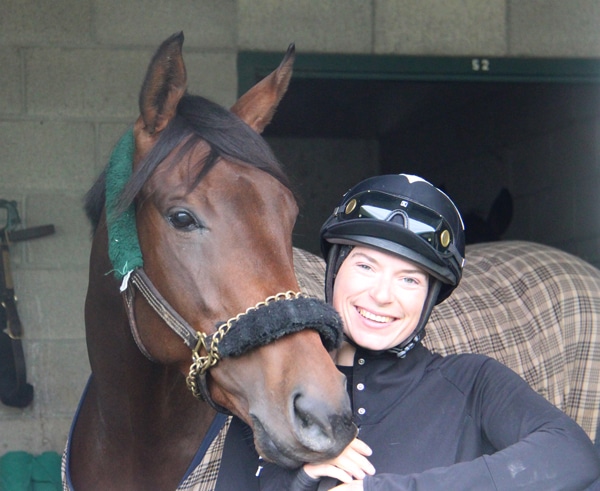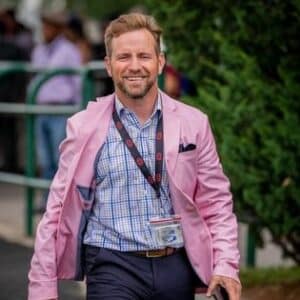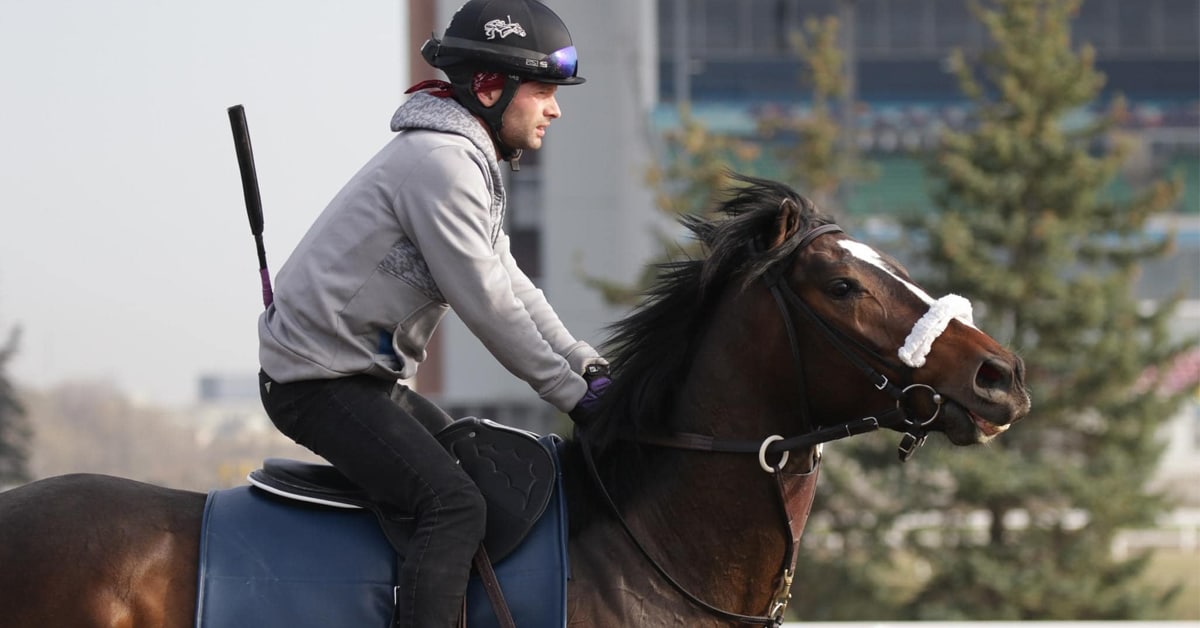“As soon as I hear that alarm, I jump up. I’ve had jobs where I don’t want to get up. Sometimes it’s seven o’clock at night and I think, ‘oh, hurry up’ – I just want to get to sleep so I can get back to work in the morning because it’s such a good feeling riding horses and seeing your horses improve.”
Cameron Sharples is standing in the rain, boots and pants caked in mud, but all smiles as we chat about his job riding horses for Kevin Attard at Woodbine Racetrack. The Canadian-born exercise rider has worked in the industry for over a decade and spent the last three years with the Attard outfit. His daily schedule starts at 5:30 a.m. and consists of riding up to seven ‘sets’ of horses a day, six days a week.
Each exercise rider is tasked with different things every day, whether to jog, gallop, or breeze a horse. While each trainer may operate differently, generally speaking they design a ‘set list’ which outlines who will ride who, on what surface (either at the main or dirt track), at what distance, etc.
Sharples hustled from the ground up to get where he is today. In 2010, he landed a co-op placement working with racehorses before his dad, Charles (Charlie) Brown, who also gallops horses, nudged his son toward getting a job at the track.
“My dad works here. He was always a rider. He told me to come here, get a job, learn the groundwork first, so that’s what I did. I went to a jumper’s school once a week and learned the fundamentals of riding,” said Sharples.

Cameron Sharples riding Lohnro’s Gamble for Kevin Attard. (Hayley Morrison photo)
In 2011, Sharples took the Old’s College exercise rider program in Alberta and then found himself back at Woodbine.
“I came straight back here and got a job with a trainer named Greg de Gannes. I’ve worked for a few trainers; you just keep learning and getting better and better,” said Sharples, who also worked for Woodbine-based trainers Paul Buttigieg and Roger Attfield.
With Buttigieg, Sharples recalls a favourite horse he loved riding at the outfit. “My favourite horse was named Phil’s Dream. As an exercise rider, that was my first stakes horse. He ended up winning champion sprinter (2013) that year, and he was nominated for Horse of the Year. That was a great year and experience for me, just becoming a better exercise rider.”
In 2020, Sharples landed a job with Kevin Attard when exercise rider and jockey Nikki Alderson mentioned the outfit was looking for riders. “I gave Kevin a call. He already knew me, he knew what kind of worker I am, and he was very happy to bring me on board,” said Sharples, who also rides horses on the farm for Attard when needed.
Back on Woodbine’s backstretch, it’s easy to spot the Attard contingent – a seamless fleet of horses decked out in red-and-white saddle blankets hustling back and forth from barn to track.
The calm and collected demeanour of exercise riders is not just for show; it’s an essential element to their trade as they continually listen and respond to the actions of their four-legged counterparts. While some horses take everything in stride, others may spook or perhaps look for ways to test their rider as they head out for a morning work. As a result, riders must remain vigilant at all times, keeping both themselves and their horses safe.
Despite the risks involved, Sharples remains passionate about his job and admits there’s an intrinsic reward that draws him back to work every day. “I always tell people if I could put that feeling of riding a good horse in a bottle it would sell for money!”
“The best job in the entire world”
Another rider who would probably agree with that statement is Miranda Truijen. Riding over at Stuart Simon’s barn, Truijen beams enthusiastically as she talks about her career as an exercise rider.
“I genuinely think I have the best job in the entire world and I ride all kinds of disciplines off the track. But there is just something about galloping a racehorse that I have never felt in anything else,” said Truijen, who grew up on a farm outside of Winnipeg.

Miranda Truijen and Twin City.
Horses have been part of Truijen’s life since childhood. She has ridden western, done show jumping, and admits to having a knack for dealing with problem horses. This knack would inevitably lead her to a racing oval.
“I loved working with problem horses. So I was training horses off the track and then this gentleman messaged me and said, ‘I have a problem horse. Here’s the address for the farm.’ When I pulled up to the farm, it was actually the track [Assiniboia Downs]. This horse used to flip over, and then I started getting on it and it didn’t flip over anymore.”
In 2016, Truijen began galloping at Assiniboia Downs in Winnipeg, Manitoba. She spent four years at the track before finding herself in Ontario at Woodbine. “I came mid-season, after Winnipeg was done, so I actually worked for Rob Love ponying until the end of that season. The next year I worked full time for Bob Tiller – who, I will say, gets full props for giving this person a galloping job right off the bat.”
Truijen has weathered some injuries during her track career. “I fractured my pelvis two years ago coming off a horse – that was not fun.” However, the eight-week recovery period did nothing to dampen her spirits about getting back in the saddle. She connected with Kelly and Slade Callaghan, who then put her in touch with Stuart Simon. Since last year, she has been a full-time rider for Simon’s barn.
Her face lights up talking about her time at the barn, and she candidly speaks about the positive experience working for ‘Stu’ as he is known to many around the barn.
“He really listens to his riders. He takes what we say very seriously. He knows that riding racehorses is challenging and that we try our best out there. So he is willing to work with you.”
Like most exercise riders, her mornings start pretty early. “My alarm normally goes off around 3:45 a.m. because I live in Caledon, which is far away. I try and leave the house around 4:00 to 4:15 a.m. to get to the track for 5:00. I can be there for 5:30, but that extra half hour gives you time to set your tack, to look over your set list of horses you’re getting on, what you are doing, and also take care of the pony.
“We have our first set at 6:00 a.m. and we will either head out to the main track or training track. Stu normally likes to send his horses to the dirt. We will get on, take a turn in the shed row, and head out. We have two sets of tack, so as soon as we come back from one set, our next horse is on the shedrow walking around, and then we basically just jump horses.” Truijen has a couple of favourites to ride in the mornings, including Seguimi and Twin City.
She shares her thoughts on what should be known about the inner workings of her beloved world. “One thing I would tell the public, that I try to stress to everybody that does not know the track, is that the horses are extremely well broke. They are spicy, but they know their jobs. You never see other horses being able to ship or stand in wash bays, and how calm they are with chaos happening around them with tractors. Really, they are not horses that just go super-fast all the time – we go slow with them, and we take care of them.”
“The love we have for the animals”
Across the road at Rodney Barrow’s barn, exercise rider Shane Straughn is also quite candid about the ‘care element’ being a focal point for the horsemen.
“There is a lot that the public doesn’t get to see. The care, the time, the effort that goes into the job. I would like them to take into consideration the love we have for the animals; it’s not just a money grab,” said Straughn, who takes a moment to chat before his last set at Barrow’s barn.

Golden Spring, ridden by Shane Straughn for trainer Rodney Barrow. (Hayley Morrison photo)
When Straughn finished high school, instead of going to college he opted to take a different path, one that led him to the track. In 2019, Straughn returned home to Barbados for four months and under trainer Robert Peirce’s tutorship, got his start in the horse racing industry. Upon returning to Canada later that year, trainer Scott Fairlie put Straughn on his first horse at Woodbine. The rider has continued to freelance for several outfits on the backstretch, finding himself in the barns of Sylvian Pion, Austin Hinds, and Rodney Barrow.
Straughn’s mornings are jam-packed with sets from different barns. “My usual day looks like 12 to 13 horses, and I’m still trying to get about 15. It’s just the timing.”
Straughn’s exercise riding journey has been anything but a walk in the park. On November 3, 2020, he was pulling up a horse one morning when the horse stumbled. “At that point, I knew it was a ‘go or stay’ type of thing, and I chose to go. As I went, his left backside hit my leg, so when I landed it messed up my ankle.”
The rider suffered a fractured ankle and snapped a tendon – injuries that put his dreams of transitioning into another type of riding on hold. “Honestly, I was prepping myself to be a jockey. I was at 122 and my weight was coming down, but when the injury happened, things slipped away, so I kind of fell off a bit. Then last year I started getting myself going again, got my strength back, my leg is fully healed,” said Straughn, who would like to race ride next year.
From jockey to exercise rider
Transitioning from exercise riding to race riding is one thing, but doing the reverse can also be challenging. Just ask former jockey Corey Fraser.
“When you go from being a jockey to galloping again, it’s a weird transition, and you almost have to learn how to gallop again,” said Fraser, who rode professionally from October 2003 until December 2012. “As a jockey, you don’t have to hold horses that much. It’s more pushing than really holding. I remember in that first year, I was a little bit sour because your ego takes a hit. As a jockey you gotta be a proud person and be your own rooting section and when it goes bad it’s not easy to take. But I have had a lot of personal growth and learned a lot of things,”

Corey Fraser.
Fraser helps out Mike Doyle’s outfit at Woodbine. Sitting in Doyle’s tack room, Fraser poignantly sums up his career in the irons. “My career compared to my peers in terms of longevity isn’t there, but I feel that I had the luckiest career. It was short, it was nine years, I rode for all the great trainers. I rode for all the people I liked. I won big races, I won a lot of races and I escaped, not getting harmed in a big way.”
After receiving the 2004 Sovereign Award for Outstanding Apprentice, Fraser went on to win several big races during his career. In 2009, he rode Gallant to victory in the Prince of Wales Stakes, the second leg of the Canadian Triple Crown, for trainer Mark Casse. He also secured several Graded 3 stakes wins, including the Bessarabian aboard Miss Concerto (2005), Mazarine Breeders’ Stakes with Coy Coyote (2006), and the Grey Stakes aboard Blue Laser (2010).
While exercise riding is something Fraser still enjoys, he’s also broadening his horizons beyond the racing oval. “I’m trying to get my real estate career off the ground. In the meantime, I need to pay bills, and my friends here need help. So, it’s like one hand washes the other.
“I have no problem leaving and not riding at the track. I’ve done my time. The one thing I wanted to do before I left, and I think I’ve sort of accomplished it – you never stop learning – was to become the rider that I wanted to be, that can get along with most horses and be a rider that would be sought out.”
“You look forward to getting up in the morning,”
Another backstretch rider is Tyler Clark, who has freelanced for several trainers including Harold Ladouceur and Julie Belhumeur. Hailing from Nova Scotia, Clark began his journey in the industry about eight years ago, working from the ground up.
“I started off as a hotwalker and a groom for Ron Sadler many years ago. I started riding a little bit each year ‒ each year I would pick up a little bit more, and now I’m a full-time exercise rider.”
Like most exercise riders, Clark’s schedule begins before sunrise. “The first set usually goes out around 5:30. I’m blessed, my horses usually don’t go out until 6, so I get a little bit of extra sleep! We will have [sets at] 6, 6:30, 7, 7:30 right up to 10 or 10:30. You are tired at the end of it, but you look forward to getting up in the morning,” said Clark, who gets on six to eight horses a day.
Exercise riding racehorses is for the brave ‒ and those willing to rise before the rest of the world. Truijen sums it up: “It really is this strange combination of doing something new every day because horses are not computers, but it’s also the consistency; you wake up every day and you know they are going to be there.”


